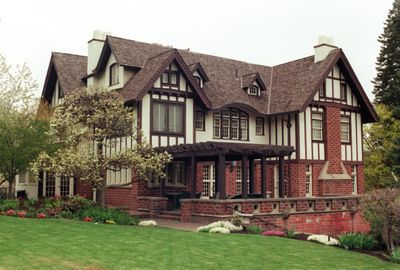Tour benefits Heritage Gardens
Mansions on South Hill will be opened to public on Saturday

A volunteer group formed to support the Moore-Turner Heritage Gardens on Spokane’s lower South Hill has organized a tour of four lavish mansions on Saturday from noon to 4 p.m. to benefit the gardens.
The four mansions in the same neighborhood as the gardens were built for well-off residents – a U.S. senator, a physician, an attorney and a banker – during the first half of the 20th century.
Proceeds will go to support the heritage gardens, which were restored over the past decade from the ruins of former estate gardens first planted in 1889. The heritage gardens in Pioneer Park at Seventh Avenue and Stevens Street were opened to the public a year ago. The Friends of the Moore-Turner Heritage Gardens are working on maintaining the site.
Here are the homes on the tour:
Nuzum House 503 W. Sumner Ave.
The Richard and Jessie Nuzum House, built in 1914, is considered a hallmark of 17th century medieval “black and white” manor houses that were popular during the Tudor era in Great Britain, according to tour organizers.
Renowned architect Kirtland Cutter designed the home, which cost $30,000, for building contractor Charles Jasper, who never lived in it. Instead, the house was first occupied by the Nuzums and retains their name for historic purposes.
Richard Nuzum was an attorney with Turner, Nuzum & Nuzum and a real estate investor. The home still has its original Sheffield silver chandeliers, a Turkish lantern from Constantinople and opalescent glass.
Crommelin House 603 W. Sumner Ave.
Built in 1908 for Amsterdam native Henri Crommelin, the 1908 mansion was designed in the Tudor Revival style with “storybook” influence.
Crommelin managed at least two banks in Spokane for more than five decades, including the Holland Bank of Amsterdam, which helped rebuild Spokane after the Great Fire of 1889, according to research compiled for the tour.
The home is reminiscent of cottages built throughout the English and Danish countrysides, and includes flourishes that have a feel of the Hansel & Gretel fairy tale, the tour guide says.
Lambert House 726 W. Sumner Ave.
The 1921 Lambert House was designed by one of the city’s most prominent and prolific architectural firms, Whitehouse & Price, and built in 1921. Its Colonial Revival styling incorporates a red brick veneer on top of hollow-core ceramic block construction, a popular building treatment in the 1920s.
The home’s lot takes in a panoramic view of the Spokane region. “The interior of the house is graciously appointed with a center reception hall and formal staircase, formal living room and dining rooms, country kitchen/sunroom, four bedrooms and a large ballroom/playroom on the third floor,” the tour guide says.
Dr. Samuel Lambert practiced medicine from his office in the Old National Bank Building and served as secretary for Spokane Surgical Supply Co. He and his wife, Helen, sold the house in 1932.
Dill House 708 W. Cliff Drive
One of the most prominent residential landmarks in Spokane, the Dill House at 708 W. Cliff Drive is a monument to political power and unique architectural design.
Built in 1941 for former U.S. Sen. Clarence C. Dill and his wife, Mabel, the Spanish Eclectic home hugs the cliff of the lower South Hill, and with 12,000 square feet of space, has six stories, multiple wings, balconies and an observation tower. The home was named “Cliff Aerie.”
Dill, an attorney, served two terms in the U.S. Senate from 1923 to 1935. While in office, he got a promise from Franklin Roosevelt to back construction of Grand Coulee Dam, which earned Dill the nickname of the “father of Grand Coulee Dam.”
Mabel Dill founded the home economics department at Whitworth College. They hosted at their home for years during Christmas a gathering with 300 to 400 children, including hospital patients and crippled children. The home was handicapped accessible and was capable of accommodating Roosevelt during a visit, the tour guide says.
The Moore-Turner Heritage Gardens date back to the construction of a mansion that predated the neighboring Corbin House in Pioneer Park. During the early part of the last century, the gardens were expanded with a pond and reflecting pool, stone walkways, terracing, arbors, tea house and conservatory. The home was eventually demolished and the gardens were lost from lack of care.
Restoration was based on extensive research that started in 1996.
Garden hours in September are on Saturdays and Sundays from 10 a.m. to 4:30 p.m. The gardens close for the season on Sept. 28 and will reopen next May.